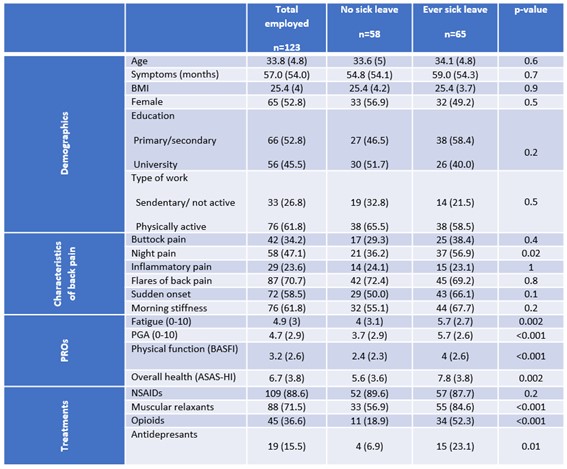Session Information
Date: Tuesday, November 14, 2023
Title: (1973–1976) Orthopedics, Low Back Pain, & Rehabilitation Poster
Session Type: Poster Session C
Session Time: 9:00AM-11:00AM
Background/Purpose: Chronic back pain (CBP) is one of the major causes for medical consultation among young people. Given the limited sources, it is relevant knowing the characteristics associated with a higher burden in order to prioritize the performance of imaging exams. We aimed to identify factors associated with sick leave in a cohort of young patients with CBP awaiting an MRI of the spine.
Methods: The project “Strategy for a Hospital Early Referral in Patients with Axial Spondyloarthritis” (SHERPAS) is a prospective ongoing study recruiting young patients (18 to 40 years) with CBP that are requested an MRI of the spine by other specialists different than rheumatologists in a tertiary hospital. The study period started in September 2021, and the dataset for this interim analysis was locked in October 2022. Patients completed a questionnaire concerning work status, including sick leave due to CBP (at-visit or prior to this). Besides, socio-demographic and clinical characteristics were collected. Patient-reported outcomes (PROs) for fatigue, Patient Global Assessment (PGA), physical function (Bath Ankylosing Spondylitis Functional Index -BASFI), and overall health (Assessment of Spondyloarthritis international Society Health Index -ASAS HI) were also evaluated. A logistic regression analysis was performed to evaluate the association of patients’ characteristics with sick leave.
Results: Of 152 recruited patients, 123 (80.9%) were actively employed, 22 (14.5%) were unemployed and 7 (4.6%) were students. Among the employed patients (52.8% female; mean age 33.8(4.8) years; 57.0 (54.0) months CBP duration), 65 (52.8%) patients had been on sick leave at some point (50 prior to visit and 15 at the study visit). Baseline characteristics are shown in Table. Night pain was more frequent in patients on sick leave (56.9 % vs 36.2%, p=0.02), and PROs on fatigue, PGA, physical function and overall health and functioning showed worse results in these patients, as compared to patients who had never been in sick leave. Additionally, patients with on sick leave had more frequently pharmacological treatment. After multivariable analysis, being male (OR 2.3, 95%CI 1.0-5.6), having night pain (OR=2.4, 95%CI 1.0-5.8) and reporting higher PGA (OR=1.1, 95%CI 1.0-1.4) were associated independently with being on sick leave.
Conclusion: One out of two young patients with CBP awaiting an MRI of the spine are on sick leave at some point. These patients have poorer quality of life and use more pharmacological treatment than active patients with CBP. Male sex and night pain are associated with being on sick leave due to CBP and therefore could be used to prioritize the use of spinal MRI aiming to optimize health resources.
To cite this abstract in AMA style:
Benavent D, Tapia M, Bernabeu D, muley V, Plasencia-Rodríguez C, Balsa A, Navarro-Compán V. Work-related Impact in Young Patients with Chronic Back Pain Awaiting a Magnetic Resonance Imaging [abstract]. Arthritis Rheumatol. 2023; 75 (suppl 9). https://acrabstracts.org/abstract/work-related-impact-in-young-patients-with-chronic-back-pain-awaiting-a-magnetic-resonance-imaging/. Accessed .« Back to ACR Convergence 2023
ACR Meeting Abstracts - https://acrabstracts.org/abstract/work-related-impact-in-young-patients-with-chronic-back-pain-awaiting-a-magnetic-resonance-imaging/

